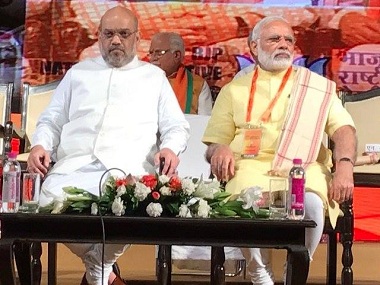According to trends of the results of the by-elections for four Lok Sabha seats and 11 Vidhan Sabha seats across 10 states available at the time of writing, the BJP has sufficient reasons to worry. The figures currently available, also show that the Congress, if it wishes to stage a revival on the national stage, has to focus and maximise gains immediately in states, regions and seats where it is either locked in a bipolar contest with the ruling party or is a dominant player. Only if it has a sizeable number of seats in its kitty from this lot will the party stand a chance of emerging as a player of significance. [caption id=“attachment_4489831” align=“alignleft” width=“380”] File image of Amit Shah with Narendra Modi. Facebook/BJP[/caption] Likewise, the task cut out for big regional parties opposed to BJP is to align with other opposition parties to forge all-embracing alliances against the ruling party. Even smaller regional parties which have a significant presence in just a small number of seats or very small regions, must not be over-ambitious and field more candidates as a division of anti-BJP votes will spell doom for all these parties. The big story is the Kairana bypoll in Uttar Pradesh. A western Uttar Pradesh seat in the heart of what is termed Jat land, it was won by the BJP in 2014 in the wake of the Muzaffarnagar riots in 2013 which triggered unprecedented levels of communal polarisation in the region. This was evident in the party candidate, Hukum Singh securing more than 50 percent vote share, even more than the total votes of the Samajwadi Party, Bahujan Samaj Party and Rashtriya Lok Dal candidates, contesting separately. The Congress did not contest the poll. The BJP hegemony held firm during the 2017 Assembly elections too and its won four of the five Assembly seats which are part of the Lok Sabha seat. One of the primary reason for the BJP doing so well in a seat where Muslims account for almost 35 percent of voters, is Hindu consolidation in 2014 which remained firm in the Assembly polls last year. It was evident from the results that not just OBCs and upper castes rallied behind BJP, but even Dalits backed the saffron party in significant numbers. The trends so far suggest significant dent in this consolidated Hindu vote base. That the disenchantment with BJP extends to Noorpur Assembly constituency in neighbouring Bijnore district, shows that the Hindutva wave has not worked this time and resentment against the BJP for its social policies got intertwined with farmers’ anger over non-payment of sugarcane dues despite promises the Centre and the state government. Clearly, Jat animosity towards Muslims has been diluted in Western Uttar Pradesh and the tactical gamble of the united opposition to put up a Muslim candidate, Tabassum Begum, has worked and proved that the BJP’s past strategy of ‘reverse polarisation’ in seats numerically dominated by Muslims, has not worked this time. This has exposed the limitations of the Hindutva card starkly for the first time in a communally sensitive seat. Additionally, this was a seat that the BJP contested more keenly than Phulpur and Gorakhpur. Even Prime Minister Narendra Modi controversially addressed a public rally in adjoining Baghpat a day before voting and after campaigning formally ended. His rally after inaugurating the Eastern Peripheral Expressway had drawn criticism because his speech was essentially political in nature. In Uttar Pradesh, it is thereby evident now, the BJP will face a major challenge in wake of the all-out opposition unity. This will add to the worrying signal from Bihar where the BJP’s partner, Nitish Kumar’s Janata Dal (United) is possibly heading for a comprehensive defeat. This will be quick on the heels of electoral reverses in by elections in March this year. With Uttar Pradesh and Bihar accounting for 120 Lok Sabha seats of which the BJP and its allies won 104 of these seats, the scenario is getting scary for the party. It is anyone’s guess if the loss in these two states would be compensated adequately in states where the party did not do as well in 2014. The overlying message from the by election results is that the BJP is managing to hold on to those seats where opposition votes are getting divided. This is most evident in the Palghar (ST) Lok Sabha seat in Maharashtra where the BJP was ahead, primarily because the anti-BJP vote was split after the Shiv Sena also fielded a candidate. In addition to this, for Jharkhand’s Gomia assembly constituency the BJP and All Jharkhand Students Union (AJSU) contested against each other despite the latter being part of the ruling National Democratic Alliance (NDA) alliance. This is clearly indicative of BJP’s continuing problems with allies and adds to the problem stemming from the deteriorating ties with allies. For the BJP, the by election results are likely to demonstrate the danger of the continuous rise in the Index of Opposition Unity. Likewise, for opposition parties it is prudent to keep reminding one another the old proverb – united we stand, divided we fall.
The BJP hegemony held firm during the 2017 Assembly elections too and its won four of the five Assembly seats which are part of the Lok Sabha seat.
Advertisement
End of Article


)
)
)
)
)
)
)
)
)



